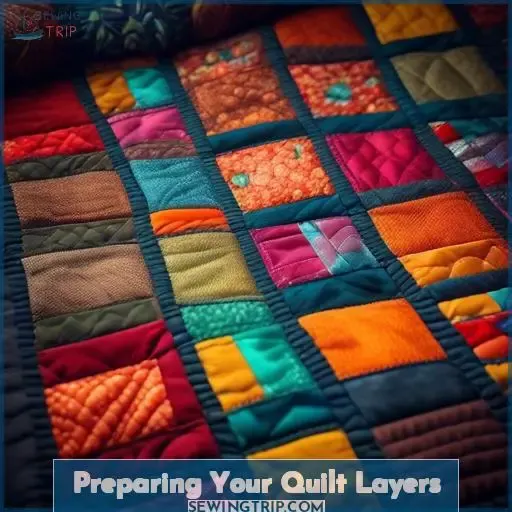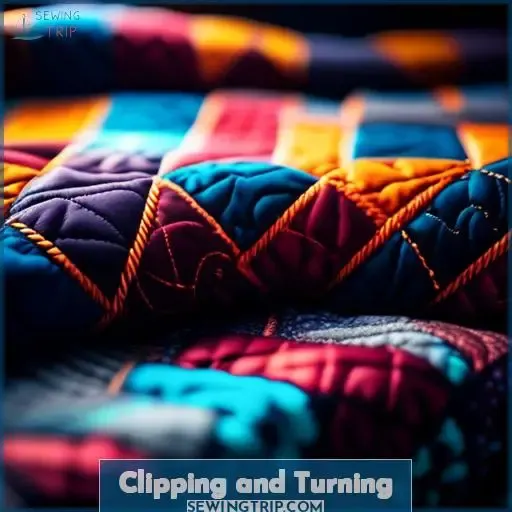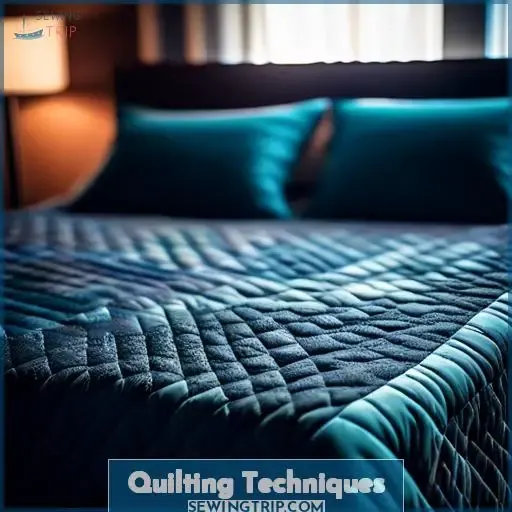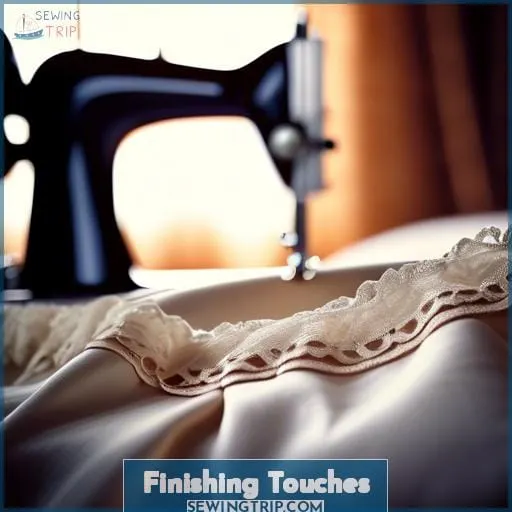This site is supported by our readers. We may earn a commission, at no cost to you, if you purchase through links.
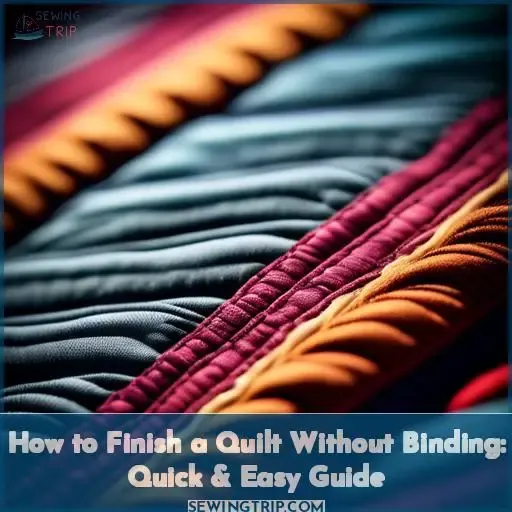
This guide is your beacon through a simpler, yet equally stunning, method to complete your quilting projects. You’ll discover quick and easy steps that not only save time but also give your quilts a modern edge.
Embrace the freedom of binding-free quilting, and let’s dive into techniques that ensure durability, beauty, and a touch of innovation to your craft.
Table Of Contents
Key Takeaways
- Layer the quilt by placing batting between the backing and quilt top, ensuring all layers are pinned together securely to prevent shifting during sewing.
- When sewing the edges, use a 1/2-inch seam allowance, select a thread color that complements the fabrics, and ensure to clip the corners diagonally before turning the quilt right-side-out for sharper corners.
- Utilize various quilting techniques such as stitching in the ditch, creating straight lines or grid patterns with a Hera marker, and experimenting with different quilting designs and fabric choices to add texture and interest to the quilt.
- For a clean finish without binding, carefully iron and press the quilt flat, trim any excess batting, and meticulously close any gaps, ensuring the edges are well-finished and the quilt maintains its shape.
How to Finish a Quilt Without Binding
To finish a quilt without binding, you can use the pillowcase or birthing method where the quilt is sewn right sides together, then turned inside out, or apply a self-binding technique using the quilt’s backing fabric.
These methods are quick, easy, and eliminate the need for traditional binding strips.
Preparing Your Quilt Layers
You’re ready to start your quilt, and the first step is all about preparation. Let’s cut to size, layer, and pin your materials together—it’s simpler than you think!
Cutting to Dimension
Ready to slice and dice your quilt’s layers? First, ensure your backing size and quilt top are cut to match—like two peas in a pod. Next, cozy up the batting between them, aligning all edges like a perfect sandwich.
Secure the trio with strategically placed pins, making sure they’re snug as a bug for a smooth quilting adventure.
Layering and Pinning
Alright, let’s dive into the cozy world of quilt-making!
When you’re layering your quilt, think of it as a fabric sandwich. The bread? Your quilt top and backing, with right sides facing each other.
The filling? That’s your quilt batting. Aim for pinning consistency to keep the fabric tension even, and align those edges like a pro.
Sewing the Edges
Once you’ve got your quilt layers cozy and snug, it’s time to dive into sewing the edges.
- Set your seam allowances to a reliable 1/2 inch for a sturdy edge.
- Choose a thread that complements your fabric choices, adding a subtle flair.
- Pick the right needle size to glide through layers like butter.
- Top stitch with confidence, securing your quilt’s edge with machine stitching finesse.
Clipping and Turning
You’ve sewn your quilt layers together; now let’s make those corners sharp and sleek. A quick clip and a careful turn will give your quilt that crisp, finished look without the bulk.
Reducing Bulk at Corners
Once you’ve sewn the edges, it’s time to tackle those pesky quilt corners. Snip them diagonally for bulk reduction, ensuring a clean finish. Flip your quilt right-side-out, and voilà, you’ve mastered corner perfection without the fuss of traditional quilt binding.
It’s like giving your quilt a neat little haircut before turning the seam for that crisp, basting stitch-beautiful corner.
Achieving Perfect Corners
After trimming those pesky corners, you’re on the home stretch. Here’s how to nail those corners with flair:
- Use a point turner for corner precision, avoiding the dreaded corner bulk.
- Flatten each corner meticulously, ensuring corner stabilization.
- Reinforce by hand stitching, adding strength.
- Marvel at your quilt’s corners, where backing fabric meets with a crisp finish.
You’ve turned a corner in quilting mastery!
Quilting Techniques
You’ve got your quilt layers prepped and ready; now let’s tackle the quilting techniques. Stitch in the ditch, straight line quilting, and using a Hera marker for grid patterns will give your project a sleek, finished look without the need for binding.
Stitch in the Ditch
When you’re quilting, stitch in the ditch is like sneaking through a secret garden without disturbing a single petal. It’s all about guiding your needle along the seams, where the quilt top and backing coyly meet.
Choose your tools wisely—needle size, thread tension, and presser foot are your trusty sidekicks. And remember, the right machine type and fabric choice make for a smooth journey.
| Needle Size | Thread Tension |
|---|---|
| Small for delicate fabrics | Adjust for smooth stitches |
| Larger for thicker layers | Keep even to avoid puckering |
| Machine Type | Presser Foot |
| ————– | ————– |
| A trusty workhorse for speed | Use a walking foot for ease |
| Gentle setting for hand sewing | Ditch foot for precision |
Now, take a breath, and let’s dive into the ditch with gusto!
Straight Line Quilting
Dive into straight line quilting, where your machine becomes a trusty sidekick, guiding you through rows of even stitches.
Forget the free motion frenzy; here, it’s all about control and rhythm.
Keep your stitch length consistent, and let the hum of your machine serenade you as you transform each quilt block into a cozy masterpiece with quilt backing that sings harmony.
Using a Hera Marker for Grid Patterns
Dive into the art of quilting with a Hera marker, your secret weapon for creating stunning grid patterns.
Imagine your quilt as a canvas, where every line you draw with this handy tool brings you closer to a masterpiece. Whether you’re crafting an octagon or hexagon quilt, or experimenting with rainbow fabric and unusual shapes, the Hera marker ensures consistent stitching and fine details.
Embrace the freedom to explore new designs, from English paper pieced quilts to projects featuring fabric choices that challenge the norm. With the Hera marker and some ruler techniques under your belt, you’re not just making quilts; you’re weaving dreams into reality.
Finishing Touches
You’re almost there! Ironing and pressing your quilt will give it a polished look.
Ironing and Pressing
Ironing and pressing your quilt isn’t just about smoothing out wrinkles; it’s the secret sauce to a sleek finish. Think of your iron as a magic wand, transforming your quilt from just sewn to show-ready.
- Iron flat to banish any creases.
- Press seams for a polished look.
- Aim for crisp edges that scream precision.
- Ensure a flat finish, especially around the batting.
- Trim and close the gap for a binding-free masterpiece.
Trimming Excess
After ironing and pressing your quilt, it’s time to tackle those trimmed corners and excess batting. Think of it as giving your quilt a haircut; you’re snipping away the bulky edges to reveal its true shape.
| Before Trimming | After Trimming |
|---|---|
| Bulky, raw edges | Sleek, folded edges |
| Excess batting poking out | Smooth, even layers |
This step transforms your quilt from homemade to handmade, showcasing your crafty prowess.
Advantages of Binding-Free Quilting
You’ll love the sleek, modern look that finishing a quilt without binding can give your project. It’s not only quicker and easier, but it also ensures a durable and secure finish.
Modern Look and Feel
Embrace the sleekness of modernity with a binding-free quilt finish. You’ll love the simplicity it brings to your project, not to mention the clean lines that scream no fuss. This approach isn’t just about looks; it’s about versatility, too. It’s a fresh take that lets your creativity shine without the extra steps—quilt finishing made refreshingly simple.
Time Efficiency
Time efficiency in quilting without binding isn’t just a dream; it’s a reality that lets you dive right into more projects.
- Quicker finishes mean more quilts.
- Diverse stitching options keep things fresh.
- Various batting types and fabric choices expand your creative horizon.
- Play with color combinations without the extra step.
- Experiment with design patterns, making each project uniquely yours.
Durability and Security
Finishing your quilt without binding isn’t just a shortcut; it’s a game-changer. By choosing the right techniques and materials, you’re not only bagging the benefits of a sleek look but also ensuring durability and security.
Frequently Asked Questions (FAQs)
Can I use decorative stitches for quilting?
Absolutely, you can jazz up your quilting with decorative stitches! They’re a fantastic way to add personality and flair, turning the ordinary into something uniquely yours.
How do I prevent fabric from puckering?
To dodge puckering, ensure your tension’s just right, not too tight. Use a sharp needle and let your machine’s feed dogs lead the dance.
Is hand quilting without binding durable?
Rest assured, hand quilting without binding can stand the test of time, just like the classics. It’s a sturdy choice that marries tradition with a modern twist, perfect for your quilting adventures.
What are alternatives to SpraynBond for basting?
Looking for a SpraynBond alternative? Dive into the world of quilting with Elmer’s spray adhesive or homemade basting sprays.
Can this method work for irregular shapes?
Like a chameleon adapts to its environment, this no-binding quilt method flexes to fit irregular shapes, offering a canvas for your creativity without the straightjacket of traditional edges.
Conclusion
Stepping through time’s portal, you’ve now mastered how to finish a quilt without binding.
This journey has equipped you with skills for crafting quilts that boast a modern edge, are time-efficient, and durable.
Let your creativity soar and enjoy the freedom and beauty of binding-free quilting.

